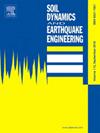Hysteretic behavior of a cross-laminated timber building incorporating different energy dissipators
IF 4.2
2区 工程技术
Q1 ENGINEERING, GEOLOGICAL
引用次数: 0
Abstract
Large-scale experiments on timber structures, incorporating damping devices, showed high-intensity earthquakes can be resisted. This paper compares cyclic response of a two-story cross-laminated timber (CLT) building with three different dampers: resilient slip friction joint (RSFJ), lead extrusion damper (LED), and linear friction damper (LFD). A CLT building with conventional hold-downs and angle brackets experimental work was used as a benchmark to validate the high-fidelity finite element model. Subsequently, the numerical model was extended to account for the three dampers. Re-centering efficiency, i.e., expected flag-shaped hysteretic response, of the RSFJ was ensured by increasing the shear strength of hold-downs. Buildings with LFD and LED have greater energy dissipation capacity when compared to buildings with conventional hold-downs. Improved energy dissipations were also observed in two buildings when increasing the shear strength of angle bracket or applying the rigid connections in the 2nd story. Finally, the performances of buildings with different dampers were evaluated.
包含不同消能装置的交叉层压木材建筑的滞后行为
对木结构进行的大规模实验表明,采用阻尼装置的木结构可以抵御高强度地震。本文比较了带有三种不同阻尼器(弹性滑动摩擦接头(RSFJ)、铅挤压阻尼器(LED)和线性摩擦阻尼器(LFD))的两层交叉层压木材(CLT)建筑的周期响应。采用传统固定装置和角托架的 CLT 建筑实验工作被用作验证高保真有限元模型的基准。随后,对数值模型进行了扩展,以考虑这三种阻尼器。通过提高支撑杆的抗剪强度,确保了 RSFJ 的重新定心效率,即预期的旗形滞后响应。与使用传统支撑的建筑物相比,使用 LFD 和 LED 的建筑物具有更强的能量耗散能力。在提高角钢支架的抗剪强度或在第二层采用刚性连接时,两栋建筑的消能性能也得到了改善。最后,对采用不同阻尼器的建筑物的性能进行了评估。
本文章由计算机程序翻译,如有差异,请以英文原文为准。
求助全文
约1分钟内获得全文
求助全文
来源期刊

Soil Dynamics and Earthquake Engineering
工程技术-地球科学综合
CiteScore
7.50
自引率
15.00%
发文量
446
审稿时长
8 months
期刊介绍:
The journal aims to encourage and enhance the role of mechanics and other disciplines as they relate to earthquake engineering by providing opportunities for the publication of the work of applied mathematicians, engineers and other applied scientists involved in solving problems closely related to the field of earthquake engineering and geotechnical earthquake engineering.
Emphasis is placed on new concepts and techniques, but case histories will also be published if they enhance the presentation and understanding of new technical concepts.
 求助内容:
求助内容: 应助结果提醒方式:
应助结果提醒方式:


